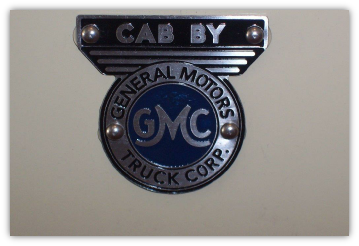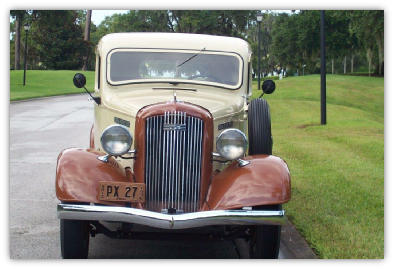
Patrick Kroeger’s 1936 GMC T-
Deluxe trim radiator ornament, standard radiator cap was a plain flat painted cap.
The AZ tag is the original tag when the truck was first registered
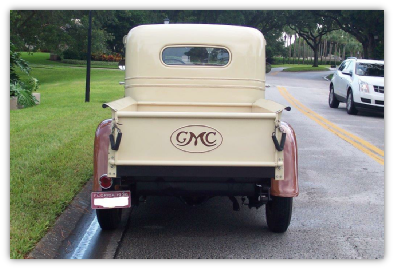
Driver side tail light, passenger side light was available as an option. Both the passenger light and bracket are near impossible to find.


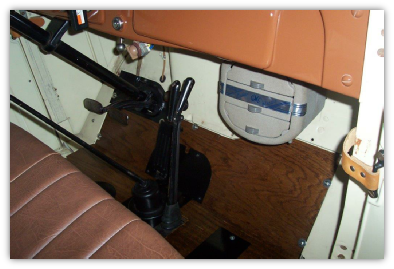
– Body emblem that was attached between door and hood on passenger side. Original was aluminum and generally throw away when the truck was repainted. This is a Stainless Steel reproduction that I had made.
– I found a 1939 GMC deluxe heater, when I got the truck it had a 1936 Chevrolet Super Deluxe heater installed.
Instrument panel showing the five gauges
When I reupholstered the seats, the shop that is local was able to get what Hampton Coach sells for about half price and is a close match to the original.

The three motor mounts for the engine had to be rebuilt (re-
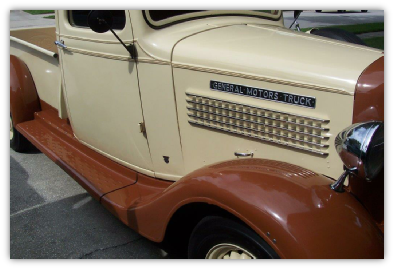
When I retired from the Dunedin Florida Fire Dept. in 2003, I started to look for
another truck to have fun with. I had previously restored a 1922 American La-
I started looking for a late 40’s to early 50’s Chevrolet truck.
While searching the Internet I found my current truck, a 1936 GMC T-
After his inspection, I decided to buy the truck and had it shipped back to Florida. I found out from the seller that he was the second owner of the truck and that the original owner had bought it new in June of 1936 for $695 and it had been registered in Pinal County AZ since new. The original owner restored the truck in 1989 and the second owner had done a few repairs.
The paint and body work was very good when I got the truck, but mechanically it was in very poor condition. Every seal and gasket leaked, the brakes were shot, the head had a crack in it, the tires were dry rotted and the wood in the bed was dried out.
In the last 11 years that I have owned it I have taken care of the above items plus
have rebuilt all of the gauges, replaced the tail gate, re-
I had no idea of the significance of this truck until I got it and started to research more about it.
This was an attempt by GMC to get into the small truck market in a larger way at the request of their dealers, who were suffering financially due to the Depression. GMC offered this truck in two versions, Standard and Deluxe with the Deluxe version having chrome headlights and stands, chrome center grill gars, radiator ornament, polished stainless hood louvers and chrome hood handles. In addition to that, GMC also offered a Deluxe Cab option that included a chrome inside rearview mirror, arm rest on driver side door, chrome windshield frame, sun glare shield, a dome light and chrome wiper arm. The chrome front bumper was an added cost accessory, also. The standard color was Murant Green with black fenders, but eleven other colors were offered either as a single color or two tone.
From what the original owner told me, mine is the original color combination,
Medium Cream and Hollywood Tan, which was a $10.29 option.
There are many similarities with the 1936 Chevrolet FB truck; notability the entire cab is identical. Although the GMC had its gas tank mounted behind the rear axle, the seat riser area has the holes for the gas tank and the indent for the gas fill is on the passenger door. The front fenders, although interchangeable, the GMC had the spare tire on the driver’s side while the Chevrolet had its spare tire on the passenger side. This may have been done to let each division have a distinctive appearance. The dash layout is the same as the Chevrolet; however the GMC had an 80 mph speedometer, a 0 to 30 ammeter gauge and 0 to 80 PSI oil pressure gauge.
The higher oil pressure gauge was necessitated by the use of an Oldsmobile sourced
engine that had insert bearings and had a full pressure oiling system. The L-
The front axle, rear axle, steering gear and transmission are identical to the both the GMC and the Chevrolet, however the GMC’s wheelbase was 126 inches compared to the 112 inches of the Chevrolet. This was accomplished with an intermediate shaft from the transmission to a carrier bearing and then the main propeller shaft to the rear axle. This required two universal joints enclosed in ball housings.
The brake system is identical to both makes with the exception of the longer lines due to the increase in wheel base of the GMC.
The taillight differed, in that GMC used a Guide R-
The other major difference between the two makes was the front end appearance. The GMC hood side panels had louvers with 5 horizontal bars and “General Motors Truck” nameplates on each side. The front grill differed from the Chevrolet in that it had 17 vertical bars. Originally, only the center seven were chromed and the outside five on each side were painted either body or grill surround color. The original owner took some poetic license with my truck.
The tailgates on both trucks were the same; with no logo on either, however mine was severely bent so I got a replacement and opted to get the 1937 version that had the GMC logo stamped into it.
I also found out after getting this truck, that 1936 was a very bad year for GM due to a labor strike that lasted for months. Production of this model GMC was limited to 11,250, of which mine is the 3229 in the production run. 1936 was also, for the most part, a single year design for GMC. Few items came from 1935 and few items transferred to 1937.
The following year, 1937 was the start of the merger of the two makes to become more and more identical year after year.
One of the nicest aspects of owning a truck like this, as any older truck owner will acknowledge, is the interaction that you have with other people. Old trucks evoke memories of people or times in their lives that they recall with fondness. Most people will recall that an older truck was a part of their life in some manner in the past. Being part of that experience is well worth the time, effort and expense that I have put into my truck.
Finally I would like to thank quite a few 1936 Chevrolet truck owners that belong to the VCCA, their knowledge and advice has been a great asset in assisting me in restoring my truck.
Great lines and showing the mounting of the spare wheel and tire.


